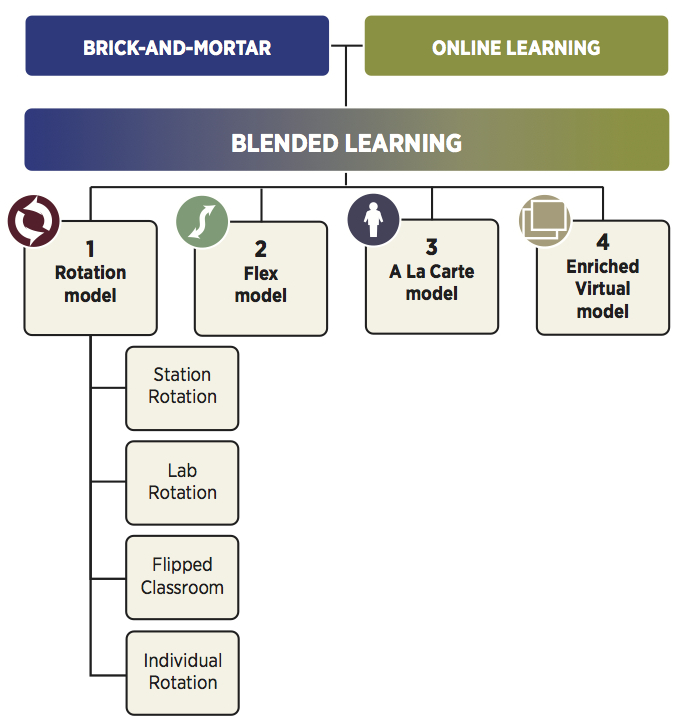according to knewton info-graphics Blended learning is a disruptive innovation in education that can take many forms. another terms of blended learning is a term increasingly used to describe the way e-learning is being combined with traditional classroom methods and independent study to create a new, hybrid teaching methodology. It represents a much greater change in basic technique than simply adding computers to classrooms; it represents, in many cases, a fundamental change in the way teachers and students approach the learning experience.
The
majority of blended-learning programs resemble one of four models:
Rotation, Flex, A La Carte, and Enriched Virtual. The Rotation model
includes four sub-models: Station Rotation, Lab Rotation, Flipped
Classroom, and Individual Rotation. - See more at:
http://www.christenseninstitute.org/blended-learning-definitions-and-models/#sthash.pUeNJ6lh.dpuf
The
majority of blended-learning programs resemble one of four models:
Rotation, Flex, A La Carte, and Enriched Virtual. The Rotation model
includes four sub-models: Station Rotation, Lab Rotation, Flipped
Classroom, and Individual Rotation - See more at:
http://www.christenseninstitute.org/blended-learning-definitions-and-models/#sthash.pUeNJ6lh.dpuf
The
majority of blended-learning programs resemble one of four models:
Rotation, Flex, A La Carte, and Enriched Virtual. The Rotation model
includes four sub-models: Station Rotation, Lab Rotation, Flipped
Classroom, and Individual Rotation - See more at:
http://www.christenseninstitute.org/blended-learning-definitions-and-models/#sthash.pUeNJ6lh.dpuf
The
majority of blended-learning programs resemble one of four models:
Rotation, Flex, A La Carte, and Enriched Virtual. The Rotation model
includes four sub-models: Station Rotation, Lab Rotation, Flipped
Classroom, and Individual Rotation. - See more at:
http://www.christenseninstitute.org/blended-learning-definitions-and-models/#sthash.pUeNJ6lh.dpuf
The
majority of blended-learning programs resemble one of four models:
Rotation, Flex, A La Carte, and Enriched Virtual. The Rotation model
includes four sub-models: Station Rotation, Lab Rotation, Flipped
Classroom, and Individual Rotation. - See more at:
http://www.christenseninstitute.org/blended-learning-definitions-and-models/#sthash.pUeNJ6lh.dpuf
The majority of blended-learning programs resemble one of four models: Rotation, Flex, A La Carte, and Enriched Virtual. The Rotation model includes four sub-models: Station Rotation, Lab Rotation, Flipped Classroom, and Individual Rotation.
1. Rotation Model
in rotation models, students were in a small group. they have to rotate in order to follow the teachers instructions during the lessons program. Rotation model divided into four rotation they are station rotation, lab rotation, flipped classroom, and individual rotation. students have to follow these all models.
2. Flex model
a
course or subject in which online learning is the backbone of student learning,
even if it directs students to offline activities at times. Students move on an
individually customized, fluid schedule among learning modalities. The teacher
of record is on-site, and students learn mostly on the brick-and-mortar campus,
except for any homework assignments
3. A Lacarte Model
a
course that a student takes entirely online to accompany other experiences that
the student is having at a brick-and-mortar school or learning center. The
teacher of record for the A La Carte course is the online teacher.
4. Enriched virtual model
Online
learning is the backbone of student learning when the students are located
remotely. The same person generally serves as both the online and face-to-face
teacher. Many Enriched Virtual programs began as full-time online schools and
then developed blended programs to provide students with brick-and-mortar
school experiences.
Blended learning give us many benefits whether for the teacher and the students. for the teacher, teacher can easily organize the class material, collecting data from the students, it will be more cheaper and effortless than traditional teaching. for the students, Blended learning give studentd an enjoyable learning process, the lessons going so easily because they are connected to the internet, students also be able to develop their ability in learning something because they can have a number of learning material from the internet.
a
course or subject in which online learning is the backbone of student
learning, even if it directs students to offline activities at times.
Students move on an individually customized, fluid schedule among
learning modalities. The teacher of record is on-site, and students
learn mostly on the brick-and-mortar campus, except for any homework
assignments - See more at:
http://www.christenseninstitute.org/blended-learning-definitions-and-models/#sthash.pUeNJ6lh.dpuf
a
course or subject in which students rotate on a fixed schedule or at the
teacher’s discretion between learning modalities, at least one of which
is online learning. Other modalities might include activities such as
small-group or full-class instruction, group projects, individual
tutoring, and pencil-and-paper assignments. The students learn mostly on
the brick-and-mortar campus, except for any homework assignments.
a. Station Rotation — a
course or subject in which students experience the Rotation model within
a contained classroom or group of classrooms. The Station Rotation
model differs from the Individual Rotation model because students rotate
through all of the stations, not only those on their custom schedules.
b. Lab Rotation – a course or subject in which students rotate to a computer lab for the online-learning station.
c. Flipped Classroom – a
course or subject in which students participate in online learning
off-site in place of traditional homework and then attend the
brick-and-mortar school for face-to-face, teacher-guided practice or
projects. The primary delivery of content and instruction is online,
which differentiates a Flipped Classroom from students who are merely
doing homework practice online at night.
d. Individual Rotation – a course or subject in which each student has an individualized
playlist and does not necessarily rotate to each available station or
modality. An algorithm or teacher(s) sets individual student schedules.
- See more at: http://www.christenseninstitute.org/blended-learning-definitions-and-models/#sthash.pUeNJ6lh.dpuf
1.
Rotation model — a course or subject in which students - See more at:
http://www.christenseninstitute.org/blended-learning-definitions-and-models/#sthash.pUeNJ6lh.dpuf

Tidak ada komentar:
Posting Komentar